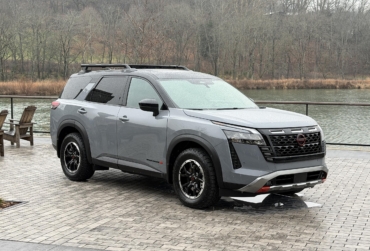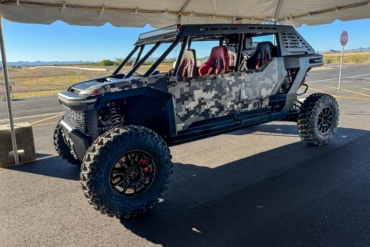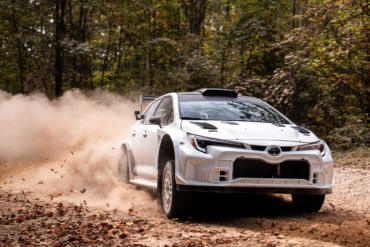The Porsche Cayenne Coupe E-Hybrid shows powerful promise and a green-friendly drive. We spent a week behind the wheel to see if this eco-performance SUV can deliver.
It’s a Porsche with an identity crisis; a Cayenne SUV that’s a coupe, a 455-horsepower performance vehicle but a plug-in hybrid. It’s an SUV, but is it an off-roader? Maybe it’s just a way to make it easy being green.

The Cayenne range certainly won’t leave you wanting for choice. Porsche makes 18 different versions of the model, split evenly between the more upright Cayenne called an SUV and this sleeker body-badged Coupe. Inside that range, you’ll find V6 and V8 engines, along with plug-in hybrids, like this one.
In the hierarchy of the Porsche Cayenne range, the E-Hybrid sits low, just one notch above the base V6 version. Take a look at power outputs, though, and suddenly it becomes more impressive.
With 455 horsepower, the Cayenne Coupe E-Hybrid out-shoves the GTS model. Instead of a twin-turbo 4.0L V8, the E-Hybrid does it with a 3.0L twin-turbo V6 and an electric motor mounted in front of the eight-speed automatic.
Cayenne Coupe E-Hybrid Adds 134 Horsepower

The V6 delivers 335 horsepower and 332 pound-feet of torque, the electric motor another 134 ponies and 295 torques. Net result: 455 horsepower and a healthy 516 pound-feet of torque.
It’s not as quick as the V8 GTS, though. It’s half a second slower to 60 mph (4.2 versus 4.8 seconds) by the stopwatch, even when equipped with the Sport Chrono Package and the lovely dashboard clock that accompanies it. The feature also includes launch control and a button that turns everything to the most sport mode possible for 20 seconds.
While the E-Hybrid has a 17.9kWH battery and that electric motor to drag around, the weight difference isn’t much compared with the V8’s extra cylinders. About 333 pounds on a vehicle that weighs around 5,200 to start with shouldn’t eat into performance too much.
That leaves us unsure why the Cayenne E-Hybrid is slower. But we do know that it’s sluggish in more than just launch-control drag race mode. This SUV doesn’t feel like it makes 455 horsepower at any point in the drive.
It’s not slow — it just never feels as quick as it should be. That’s not something you want to feel in a six-figure style-forward performance SUV. Almost like it knows, the optional performance exhaust sound is subdued even when in the louder Sport modes.
Electric Boost Allows 17-Mile Range

So what are you getting with all of this electric hardware? The ability to drive an estimated 17 miles on electric power, according to government ratings. Then, 21 miles per gallon combined once the battery charge is depleted.
That’s a significant boost versus the 17 miles per gallon a GTS claims to offer or even the 19 combined of a base V6. My time in the Cayenne E-Hybrid showed that close to 30 miles of electric driving was possible and that 26 mpg was easily attainable.
Plus, when you’re on electric power in town, the Cayenne Coupe feels more natural.
This Porsche Hates Going Slow

This is a vehicle that hates half-measures. Pull away from a stop slowly (like you would in E-Power mode) and it’s perfectly happy. Floor the accelerator and leave that stop sign with your hair on fire and it’s perfectly happy.
Try something in the middle, and it seems confused, pulling away and then lurching forward when it decides that you really should be going faster. In E-Power mode, it doesn’t have enough shove to do that.
That no half-measures attitude is pervasive, affecting the drive as well as the powertrain. My test model had all of the available handling add-ons: Dynamic Chassis Control (PDCC), which actively tweaks the roll bars to eliminate roll, adaptive air suspension, and rear-axle steering, which should increase stability on the highway and cut the turning circle in town.
Despite (or possibly because of) all of those gadgets, the Cayenne E-Hybrid Coupe felt fidgety at low and high speeds. Darting around inside its lane, following every single mark on the pavement, those visible and those not, like a dog that has just picked up the smell of the off-leash park.
Cayenne Coupe Comes Alive

Find a place where you can start to approach the Cayenne’s limits, and it feels unleashed. The hefty steering wheel no longer jumps around in your hands. Now it is ready to run — finally happy when you’re tackling a highway interchange, and suddenly disappointed once again when you’re back in a straight line.
The active air suspension is incredibly capable of controlling this heavy Porsche. Even the biggest bumps are handled with little more than a thump from the tires. Like a steamroller over fresh asphalt, the road bent to the will of the car and not the other way around.
PDCC’s anti-roll control is also shockingly good at keeping the Cayenne level, even when it’s time to toss it around. I was tempted to see if it could handle my coffee cup without a lid. With the houndstooth cloth that was part of the $17,480 “Lightweight Sport Package in Carbon Fiber,” I determined that was a bad idea.
Still Offers Off-Road Capability

The latest Cayenne might not be the off-roader the original was, but Porsche hasn’t moved away from rough-road capability completely. Press the off-road button and the suspension is raised from 6.3 inches at its lowest (7.4 in normal mode) to 9.6 inches. Thanks to the air suspension and softer roll bars permitted by PDCC, it’s firm on gravel and rocks but still compliant.
Taking the Cayenne Coupe down cottage paths should be no sweat. Just watch out for anything that could puncture the ultrawide tires, as they’re more suited to pavement.
Coupe Cuts Cargo, Towing Capacity Remains

This is a Cayenne Coupe, and that means Porsche has decided to make the roofline round instead of square. That cuts into cargo space for gear, but the amount depends on how you plan on loading it.
If you’re putting in groceries or luggage and not going above the tops of the rear seats, the cargo space is identical. If you’re filling it with balloons (or tall boxes or bikes), you might want the extra height. You can even throw a factory-supported tent on the roof.
Purely by the numbers, the Cayenne Coupe E-Hybrid gives you 17.6 cubic feet with the seats up and 50.8 cubic feet with them folded. The SUV-badged Cayenne holds 22.7 cubic feet and 56.8 cubic feet with them folded. Both can tow up to 7,716 pounds, which is an impressive figure for any crossover in this size class or with this much performance.
The rest of the cabin is plenty spacious. Loads of headroom front and rear, aided by the option of a fixed roof instead of a glass panel. Even with the available panoramic sunroof, though, this is a large vehicle for a driver and three passengers.
For comfort, eight-way adjustable front seats are standard. My tester had the 18-way adjustable adaptive sports seats that let you tweak the side and bottom bolsters and extend the bottom seat cushion. If you can’t get cozy in these, I’m not sure what to tell you.
Cabin Feels Perfectly Porsche

The cabin layout is easy to use, too. Keys surrounding the gearshift take you directly to all of the important features like chassis, nav, and even the off-road-specific settings. The flat panel has haptic feedback, so if you press a virtual button, you’ll feel a click.
It looks clean but is still functional. The drive mode selector is right on the wheel, and that includes a button that exists solely to trigger the 20 seconds of Sport Response mode where everything is tweaked to the max.
Midway through the model year 2022, Porsche upgraded Cayenne’s infotainment system. Aside from some interface and tile layout tweaks, Porsche added wireless Android Auto (wireless CarPlay was already offered) and integrated Spotify into the system. If you’re an Android user, watch for the later-year models or a 2023.
If you use iOS, you probably don’t care about the changes. Full disclosure, our tester was an early 2022 model without those changes. We were given the chance to try out the new system back to back in a different Porsche and found the changes subtle but useful.
The downside of Porsche’s flat-panel center console is that it’s obvious what features you’re missing. In the case of this Cayenne, the ventilated seat button was staring at us with nothing to do.
Have It Your Way

That’s not necessarily a downside, though. Porsche lets you configure your Cayenne almost exactly how you want it, to a level few automakers do at any price point. This unit was optioned without radar cruise, ventilated seats, or even a heated steering wheel.
But you could get all of those (plus some others) for less money simply by opting for the Sport Design Package instead of the Lightweight Sport Package. Or with hundreds of other option configurations. Want a carbon fiber owner’s manual cover? You can do that, too.

Porsche Cayenne Coupe E-Hybrid: An SUV?
One of the options you should get is the surround-view camera. The standard reversing camera is shockingly low-resolution for a vehicle this new.
Starting from the basic $91,800 for the Porsche Cayenne E-Hybrid Coupe, it’s easy to spend weeks configuring a Porsche model just how you want it, the way I would as a kid with well-worn dealer brochures. This one has been curated very specifically, with about $34,800 in options taking the price to $126,600.
Though it says “coupe” in the name, the Cayenne Coupe E-Hybrid does a great job of being an SUV, both on and off-road. But it should feel as quick as the numbers suggest, and Porsche needs to sort out the chassis’ excitement in everyday driving.








